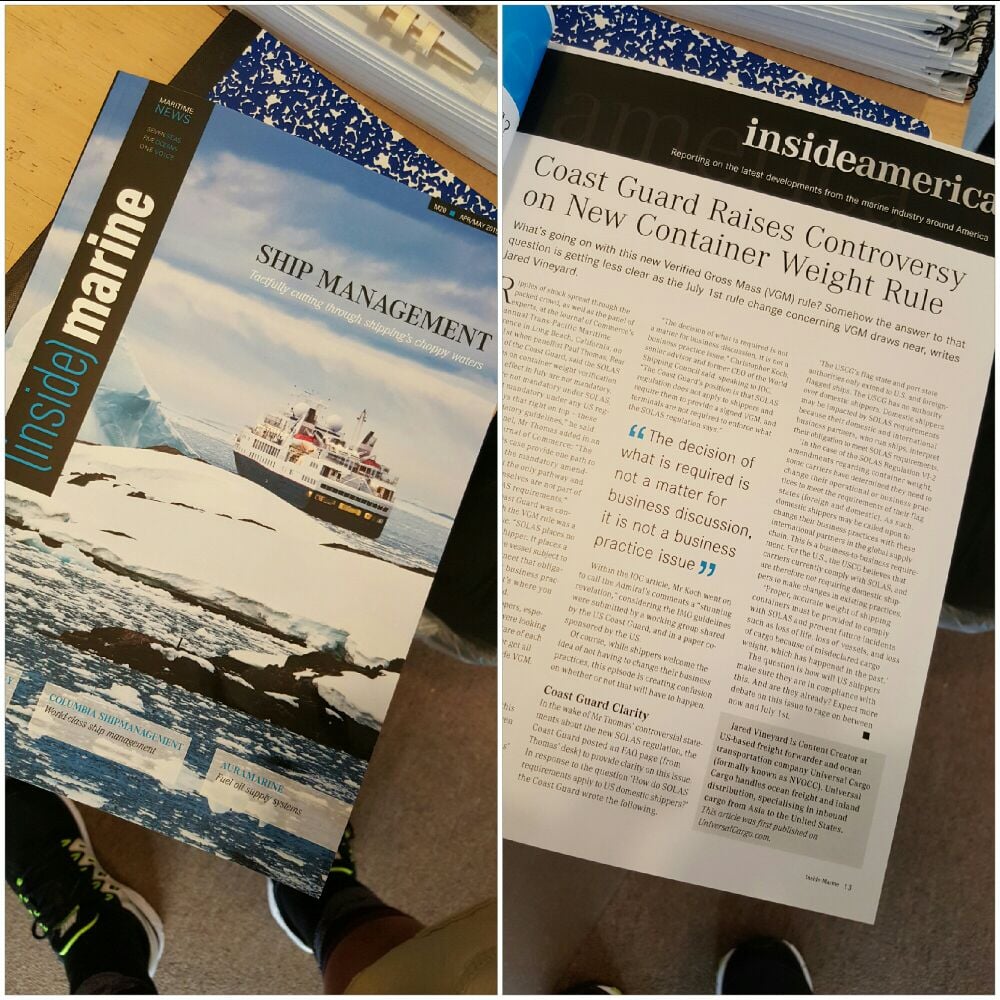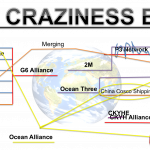Coast Guard Says U.S. Laws Equivalent to New VGM Rule
As July 1st draws nearer, nervousness increases about the new Verified Gross Mass (VGM) rule going into effect then.
 A couple months ago, the U.S. Coast Guard (USCG) upped controvercy on the topic, suggesting U.S. shippers are already in compliance with the upcoming VGM rule.
A couple months ago, the U.S. Coast Guard (USCG) upped controvercy on the topic, suggesting U.S. shippers are already in compliance with the upcoming VGM rule.
(The blog I wrote on that has since been published in Inside Marine Magazine.)
Despite backlash from the World Shipping Council, the USCG does not seem to be backing down from the stance that U.S. shippers are already in compliance.
In fact, the Coast Guard filed an equivalency with the International Maritime Organization (IMO) concerning the International Convention for the Safety of Life at Sea (SOLAS) VGM regulation about to go into effect.
The USCG also published a Marine Safety Information Bulletin for the public “to minimize confusion” on the subject and clarify the “apparent misunderstandings about the sufficient flexibility in the SOLAS regulation to allow for various methods of calculating, verifying and communicating verified gross mass, VGM.”
The contents of the bulletin are shared below, but the key statement in it is the document’s first sentence:
“The Coast Guard has determined that existing U.S. laws and regulations for providing verified container weights are equivalent to the requirements in SOLAS Regulation VI/2.”
In other words, U.S. shippers are already in compliance with the new, upcoming regulation according to the USCG.
Where the Coast Guard thinks confusion is coming in is on how the VGM must be provided. There is more flexibility than many people believe the new regulation provides. According to the USCG bulletin, terminals can be authorized to do the actual container weighing instead of shippers themselves and carriers can provide the actual container weight, allowing shippers to focus on the weight of their cargo and dunnage.
There is still debate on whether this rule amendment will seriously affect procedural operations for U.S. shippers; however, the Federal Maritime Commission appears to be on the Coast Guard’s side according to an American Shipper article:
Federal Maritime Commission (FMC) Chairman Mario Cordero commended the Coast Guard for issuing a bulletin last week on how shippers can comply with the new requirement that shippers provide the verified gross mass of containers before they are loaded on ships.
…
“I commend the Coast Guard for issuing its Marine Safety Information Bulletin last week declaring ‘…the United States has determined that the regulatory regime in the United States for providing verified weights of containers to ship Masters is equivalent to the requirements provided for…’ by SOLAS amendments,” said Cordero.
“I hope this action permits shippers, carriers, and marine terminal operators to have the knowledge necessary to continue to move cargo efficiently, reliably, and without interruption come July 1st.”
No one wants to see interruption to the supply chain. There are still those that insist this new rule will cause big, labor-intensive procedural changes for shippers, but it’s looking more and more like business as usual for international shippers in the U.S.
Here are the contents of the Coast Guard’s Marine Safety Information Bulletin as promised:
U.S. Declares an Equivalency to Regulation VI/2 of the International Convention for the Safety of Life at Sea (SOLAS)
The Coast Guard has determined that existing U.S. laws and regulations for providing verified container weights are equivalent to the requirements in SOLAS Regulation VI/2. The Coast Guard sent to the International Maritime Organization (IMO) a letter outlining its determination that its current regulatory regime provides for other entities within the container export chain to work in combination with the shipper to determine and verify container weights, and it provides ships’ masters with container weights in order to ensure ships are loaded and operated safely.
This equivalency acknowledges the dynamic and flexible business relationship between the entities in the export chain, and it provides flexibility for these entities to reach arrangements in order to ensure compliance with the SOLAS amendments that come into effect on July 1, 2016. Shippers, carriers, terminals, and maritime associations have outlined multiple acceptable methods for providing verified gross mass (VGM). A couple examples are: (1) the terminal weighs the container, and when duly authorized, verifies the VGM on behalf of the shipper, and (2) the shipper and carrier reach agreement whereby the shipper verifies the weight of the cargo, dunnage, and other securing material, and the container’s tare weight is provided and verified by the carrier.
For the purposes of determining the VGM of a container, any equipment currently being used to comply with Federal or State laws, including the Intermodal Safe Container Transportation Act and the container weight requirements in 29 CFR 1918.85(b), are acceptable for the purpose of complying with SOLAS.
The Coast Guard, in the normal course of vessel inspections under its flag state and port state control authorities, will continue to verify that ships’ masters receive the VGM of containers in order to ensure that ships are loaded safely and operate within their structural and stability safety limitations.
![]()
Source: UC Blog




